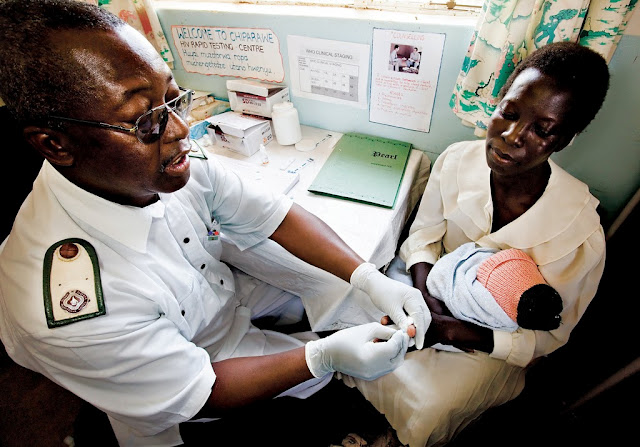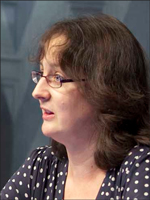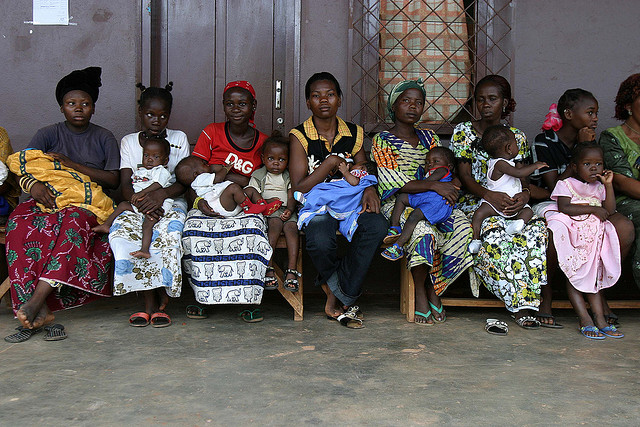Showing posts by Ramona Godbole.
-
A Lens Into Liberia: Experiences from IRP Gatekeepers
›The International Reporting Project (IRP) gives “editors – the ‘gatekeepers’ – a chance to get out of the newsrooms and to see for themselves the importance of international affairs,” said John Schidlovsky, director of IRP, at a Wilson Center event about the independent journalism organization’s recent two-week trip to Liberia with 11 U.S. news editors. [Video Below]
Schidlovsky stressed the importance of providing international opportunities for journalists in the face of news industry budget cuts. IRP fills the gap by sending gatekeepers, who help determine what news items will be selected for publication or broadcast, to countries that are often underrepresented and neglected in mainstream media.
Three of the gatekeepers, Sunni Khalid, managing news editor at WYPR Baltimore; Ed Robbins, a video journalist; and Teresa Wiltza, senior editor for The Root, shared their observations from their Liberia trip, as well as their insights into the challenges of international reporting.
Economic Challenges and Opportunities
Liberia is slowly beginning to rebuild its economy after a 14-year civil war with more than 200,000 casualties, but there are still “tremendous challenges,” said Khalid. “How do people survive? What kind of jobs do they have? How do they feed their families?”
According to World Bank figures, 84 percent of Liberians earn less than $1 a day, and more than 94 percent earn less than $2 a day. The government’s annual budget is only $369 million, the official unemployment rate is 85 percent, and corruption and lack of infrastructure remain major concerns.
Despite these problems, “Liberia has a lot of good points going for it,” said Khalid. Investment in the country’s raw materials is growing; most recently, the country signed a $7 billion deal with China and a European consortium to continue iron-ore mining.
Initially expecting to “write an obituary for Liberia,” Khalid said he “came out of this trip fairly optimistic about Liberia’s future.” With its “small population, great location, and mineral wealth,” as well as “competent political leadership,” Liberia can take advantage of its potential, he said.
“Capturing the Flavor” of Liberia
Robbins hopes to paint a multidimensional picture of Liberia and “capture the flavor of the country beyond Monrovia,” with his series of short films, which will be available on the websites of both Time and the International Reporting Project,
Robbins previewed one of these films, a profile of the chair of the Liberian Women’s Initiative, Etweda “Sugars” Cooper, who he says “embodies a certain power of a lot of Liberian women in her dedication and also her love for the country.”
At the local level, “the problems of recovery and development are all there in miniature,” said Robbins. But with dedicated leadership from people like Cooper, communities are slowly beginning to rebuild the schools, roads, hospitals, and other infrastructure that was destroyed in the civil wars.
“When you read books and articles, it tends to be really focused on the war and the devastation,” said Robbins. But there is also a sense of optimism among Liberians: “you can see hope in these people, a sense there is something there,” he said.
Empowering Women and Ending Rape
Wiltz pointed out that, “there is a prevailing sense of hope,” particularly among the older generation of women. After years of violence, these female “peace warriors” led the movement that ended Liberia’s civil war. But seven year later, “for women there, the biggest issue is that of economic empowerment,” said Wiltz. “They’re feeling empowered, but they’re broke.”
Sexual violence has become “part of the national psyche,” Wiltz said. During the civil war in Liberia, it has been estimated that more than 60 percent of the female population was raped. Today, “everyone seems sensitized to the issue, and yet it’s still a huge problem,” she said. Sexual violence is still common despite the prevention efforts of radio campaigns, NGOs, and Liberian President Ellen Johnson-Sirleaf.
“You’re in a country where families were destroyed by war,” Wiltz said. In the process of rebuilding Liberia, the new challenge is to engage and empower a new generation of young women and girls. “Underneath the surface there is all this pain and this legacy of extreme cruelty, but they very much want to overcome this.”
Much of the gatekeepers’ coverage is available online: Sunni Khalid produced a week-long series of radio pieces for WYPR, an NPR affiliate; Ed Robbins produced a series of short films for Time; and Teresa Wiltz published several articles on The Root.
Sources: CIA World Factbook, U.S. State Department, World Bank, World Health Organization, WYPR.
Photo Credit: “Liberia Will Rise Again,” courtesy of flickr user Jason Judy. -
National Geographic’s Population Seven Billion
›The short feature above and accompanying cover article in the January 2011 issue launch National Geographic’s seven-part year-long series examining global population. The world is set to hit seven billion this year, according to current UN projections, and may reach nine billion by 2045.
The authors point out that today, 13 percent of people don’t have access to clean water globally and 38 percent lack adequate sanitation. Nearly one billion people have inadequate nutrition. Natural resources are strained. Is reducing population growth the key to addressing these problems?
Not according to Robert Kuznig, author of National Geographic’s lead article, who writes that “fixating on population numbers is not the best way to confront the future…the problem that needs solving is poverty and lack of infrastructure, not overpopulation.”
“The most aggressive population control program imaginable will not save Bangladesh from sea-level rise, Rwanda from another genocide, or all of us from our enormous environmental problems,” writes Kuznig. Speaking on NPR’s Talk of the Nation last week, he reiterated this message, saying global problems “have to be tackled whether we’re eight billion people on Earth, or seven, or nine, and the scale for them is large in any case.”
Instead, the challenge is simultaneously addressing poverty, health, and education while reducing our environmental impact, says Kuznig.
“You don’t have to impose prescriptive policies for population growth, but basically if you can help people develop a nice, comfortable lifestyle and give them the access to medical care and so on, they can do it themselves,” said Richard Harris, a science correspondent for NPR, speaking with Kuznig on Talk of the Nation.
Kuznig’s article highlights the Indian state of Kerala, where thanks to state investments in health and education, 90 percent of women in the state can read (the highest rate in India) and the fertility rate has dropped to 1.7 births per woman. One reason for this is that educated girls have children later and are more open to and aware of contraceptive options.
Whither Family Planning?
In a post on Kuznig’s piece, Andrew Revkin, of The New York Times’ Dot Earth blog, points to The New Security Beat’s recent interview with Joel E. Cohen about the crucial role of education in reducing the impact of population growth. Cohen asks: “Is it too many people or is it too few people? The truth is, both are real problems, and the fortunate thing is that we have enough information to do much better in addressing both of those problems than we are doing – we may not have silver bullets, but we’re not using the knowledge we have.”
Although the National Geographic article and video emphasize the connections between poverty reduction, health, education, and population growth, both give short shrift to family planning. It’s true that fertility is shrinking in many places, and global average fertility will likely reach replacement levels by 2030, but parts of the world – like essentially all of sub-Saharan Africa for example – still have very high rates of fertility (over five) and a high unmet demand for family planning. Globally, it is estimated that 215 million women in developing countries want to avoid pregnancy but are not using effective contraception.
Development should help reduce these levels in time, but without continued funding for reproductive health services and family planning supplies, the declining trends that Kurznig cites, which are based on some potentially problematic assumptions, are unlikely to continue.
As Kuznig told NPR, “you need birth-control methods to be available, and you need the people to have the mindset that allows them to want to use them.”
At ECSP’s “Dialogue on Managing the Planet” session yesterday at the Wilson Center, National Geographic Executive Editor Dennis Dimick urged the audience to “stay tuned – you can’t comprehensively address an issue as global and as huge as this in one article, and within this series later in the year we will talk about [family planning] very specifically.” Needless to say, I look forward to seeing it, as addressing the unmet need for family planning is a crucial part of any comprehensive effort to reduce population growth and improve environmental, social, and health outcomes.
Sources: Center for Global Development, Dot Earth, NPR, Population Reference Bureau, World Bank.
Video Credit: “7 Billion, National Geographic Magazine,” courtesy of National Geographic. -
Research Findings and Programmatic Implications
Gender-Based Violence in the DRC
›In the Democratic Republic of the Congo (DRC), “armed conflict has resulted in mass displacement and widespread sexual violence; the problem is that it hasn’t always been quantified,” said Dr. Lynn Lawry, senior health stability and humanitarian assistance specialist at the U.S. Department of Defense. Presenting findings from the first cross-sectional, randomized cluster study on gender-based violence in the DRC, Lawry was joined at the Wilson Center by Heidi Lehmann, director of the Gender-based Violence Unit at the International Rescue Committee, and Dr. Nancy Glass, associate professor at the Johns Hopkins School of Nursing and associate director at the Johns Hopkins Center for Global Health. “We found that sexual violence in these areas is conflict-related, prevalent, systematic, and widespread,” said Lawry. [Video Below]
Study Finds “Female Perpetrators”
The first of its kind in the region, the population-based, quantitative study covers three districts in the DRC and a total of 5.2 million adults. It comprehensively assesses gender-based violence, including its prevalence, circumstances, perpetrators, and physical and mental health impacts.
Overall, the study found that 2.1 million women and 1.3 million men in the region had suffered sexual violence. Nearly three-quarters of all sexual violence reported was a direct result of conflict. In the study region, 20 percent of the population fought in conflicts, and 48 percent of these combatants were female.
Further, 39 percent of female survivors and 15 percent of male survivors reported female perpetrators. “These findings challenge the paradigm of male perpetrator and female victim,” said Lawry. “Policymakers and donors should adjust societal paradigms of sexual and gender-based violence and also direct attention to female perpetrators and male survivors.” Survivors of sexual violence in conflict, both male and female, are more at risk of later becoming perpetrators, particularly if unrecognized and untreated. To “break the cycle of violence,” prevention and response programs should address the needs of survivors and combatant perpetrators of both genders.
“Community-related violence is a general crime; conflict-related violence is a war crime,” Lawry said. While many efforts have focused on the Congolese military, she called for the DRC government and the International Criminal Court to also investigate and prosecute members of rebel groups, who were found to be the main perpetrators of sexual violence and other human rights abuses in this study.
Prevention: The Best Response
“Meeting the immediate consequences of violence is not enough,” said Lehmann. To effectively address gender-based violence, programs must provide medical and social services, promote social empowerment, respond to emergencies, and take part in advocacy and coordination efforts.
In the DRC, programs supported by the International Rescue Committee serve approximately 350 to 400 survivors per month, 75 percent of whom report that the perpetrators are members of armed groups.
Scaling up is a major challenge. “Providing essential services alone require enormous investment, and there is no common understanding of comprehensive programming,” said Lehmann. “We recognize that a program alone cannot solve all of these problems, especially in the DRC.”
“Good response is about prevention,” concluded Lehmann. She recommended supporting robust, long-term programming; integrating gender-based violence prevention efforts into other sectors; and investing in partnerships. “We are not going to end the violence unless Congolese women and girls are part of the conversation.”
Pigs for Peace: A Holistic Approach
Health care, economic development, and social programs should be integrated “to provide a holistic and comprehensive approach” to the problem of gender-based violence, said Glass. “Rape destabilizes families and communities,” she said.
Survivors rarely get immediate treatment for their injuries and trauma, or the risk of HIV, STIs, and infertility. “Many rural primary health centers and hospitals have been looted of medicines and materials by rebels and soldiers,” said Glass. Conflict in the DRC has also caused health care professionals to leave unstable rural areas, and poor roads and limited transportation make it unsafe and expensive to seek care.
To rebuild families and communities, “women and men need to regain their economic resources to provide for the future of their family and community,” said Glass. Pigs for Peace, for example, has supplied more than 100 women — many of them rape survivors — and their families with pigs to set them on the path to recovery through psychological, social, and economic empowerment. This program aims not only to supplement household income, but to reduce the stigma of rape as survivors become productive parts of their families and communities.
Photo Credit: “Congo kivu,” courtesy of flickr user andré thiel. -
New Insights Into the Population Growth Factor in Development
›“We have not found any country that has developed or gotten out of poverty while maintaining high birth rates,” said Martha Campbell, president of Venture Strategies for Health and Development. “Family planning is not a cost to a Ministry of Finance – it’s an investment,” said Malcolm Potts of the University of California Berkeley.
Campbell and Potts were joined by panelists Eliya Msiyaphazi Zulu, director and founder of the African Institute for Development Policy, and Jotham Musinguzi, director of the African Region at Partners in Population and Development, for a Wilson Center discussion of the implications of rapid population growth on human and economic development. [Video Below]
Africa’s Key Population Growth Challenges
“Africa’s population of one billion can reach between 1.8 and 2.3 billion by 2050, depending on how well the continent actually does in reducing fertility,” Zulu said. In 2010, Africa accounted for 15 percent of the total world population, but current estimates suggest this will grow to 23 percent by 2050.
“Rapid growth, young age structures, and urbanization are Africa’s main population challenges,” said Zulu. “Addressing these concerns is increasingly seen to be the key to the continent’s development prospects and realization of the Millennium Development Goals.” With 40 to 50 percent of populations in Africa under the age of 15, there is “high momentum for further population growth,” he said.
“Africa has a very high demand for fertility control, and the demand will undoubtedly increase,” said Zulu. “The main challenge, therefore, is not that of demand, but how to ensure those who are in need actually have access to contraception.” In many African regions, current rates of contraception use are as low as seven percent. In some areas, as many as 97 percent of women cannot afford the full cost of contraception, he said.
“It’s not just about reducing fertility,” said Zulu. Improving education and increasing labor force opportunities will not only help populations develop economically, but will also allow African countries to take full advantage of the demographic dividend, he said.
“The international development community should build on Africa’s success stories and support efforts to achieve universal access to family planning, expand public education on reproductive matters, improve the status of women, and improve the situation in urban settings,” Zulu concluded.
Family Planning and the MDGs
“Women are dying; children are dying. They shouldn’t be,” said Musinguzi. “By investing US$1 million in family planning, you can prevent 800 maternal deaths, 11,000 infant deaths, 14,000 deaths in children under five, and 360,000 unwanted pregnancies.”
“Women are clearly saying they have a need for family planning,” Musinguzi said. Presenting statistics from sub-Saharan Africa, he noted that 31 countries have a total fertility rate of more than five. Fourteen million unintended pregnancies occur each year, but only 25 percent of women use family planning. In Uganda, for example, the population has more than doubled in less than 20 years; women on average have more than six children each; and only 18 percent of married women use modern contraception.
“For a country trying to achieve the MDGs…the question of addressing total fertility rate is very important,” said Musinguzi. Reducing unmet need for family planning services can help African countries reduce the costs of achieving several of the Millennium Development Goals, including offering universal primary education; reducing child mortality; improving maternal health; combating HIV/AIDS, malaria, and other diseases; and ensuring environmental sustainability.
Policy Implications
“This is an urgent message – waiting 10 years to get family planning back on the international agenda will be enormously costly,” Potts said. “Of all the medical interventions that exist, contraception is the single most powerful. It is the only one that can have an impact on maternal and infant mortality, on the autonomy of women, on economic progress, on social stability and the rate at which we destroy the environment,” he said.
“Education and family planning are the driving mechanisms of development – they’re synergistic,” said Potts. “One of our needs is to get economists, family planning, and development experts on the same page.”
Sources: Guttmacher Institute, Population Action International, Population Reference Bureau.
Photo Credit: Untitled, courtesy of flickr user stttijn. -
Expanding Access to Maternal Health Commodities
›“This is not just about getting quantities of drugs out, this is about saving women’s lives with really simple products that work,” said Julia Bunting, team leader of AIDS and reproductive health at the UK Department for International Development and coalition chair of the Reproductive Health Supplies Coalition, at the ninth meeting of the Global Health Initiative’s 2009-2010 Advancing Policy Dialogue on Maternal Health series. Joined by panelists Melodie Holden, president of Venture Strategies Innovations (VSI), and Elizabeth Leahy Madsen, senior research associate at Population Action International (PAI), the panel discussed the challenges and strategies for expanding access to maternal health commodities.
Integrating Maternal Health and Family Planning Supply Chains
“It is often said that the family planning and the maternal health communities have very different views of supplies… but actually [both communities] recognize that we need to explore the continuum,” said Bunting, addressing the need to integrate maternal health commodities into existing reproductive health supply chains. “I really think the stars are aligned right now for advancing this agenda,” added Bunting.
“Many of the commodities that we talk about in terms of reproductive and maternal health cost tiny amounts to deliver, but actually save lives and are some of the most cost-effective interventions we have both in public health and in broader development,” said Bunting.
No Product, No Program
“Supplies are a key element in programs to improve maternal health and they are also a tangible and visible hook to increase awareness and commitment,” said Madsen. “Policymakers whose eyes glaze over when they hear the term ‘health systems strengthening’ can grasp… much better when they learn that supply shelves in clinics are bare and that women are making great efforts to reach facilities, only to leave empty- handed,” said Madsen.
Presenting research conducted by PAI, Madsen discussed the availability of four key maternal health medicines and products in Bangladesh and Uganda including:
By focusing on supplies that target the three leading causes of maternal mortality, Madsen and her colleagues identified factors that inhibit access to these commodities and developed recommendations for strengthening maternal health supply chains.- Oxytocin: used to prevent post-partum hemorrhage
- Misoprostol: used to prevent post-partum hemorrhage
- Magnesium Sulfate: used to treat pre-eclampsia
- Vacuum Aspirators: used for treatment of early and incomplete abortion
Madsen identified several strategies to strengthen supply chains for maternal health commodities including forecasting and preparing for growing demand, advocating for government and donor support, encouraging scaling-up of community-based approaches, promoting family planning, and focusing on human resource training.
“In maternal health, if a supply to prevent or treat a life-threatening complication is in stock, there must also be a way for a woman to reach it in time… and in most cases a provider who knows how to administer it,” said Madsen.
“This research is intended to lay the groundwork for future advocacy and policy initiatives by providing an evidence base that is informed by local expertise,” said Madsen. “We hope that this information will inform program implementation, funding decisions, and awareness raising.”
Getting the Product to People: The Case of Misoprostol
“The story of Misoprostol is still being written. The goal is to invest in creating access to interventions that are low-cost and relatively simple to use,” said Holden. By sharing lessons learned, Holden described VSI’s experience registering and procuring Misoprostol and demonstrated how community mobilization is imperative to overcoming major challenges for large-scale implementation.
“Making products available is not without challenges,” said Holden. To increase access to Misoprostol in rural communities, maternal health experts must work to “engage communities, educate and mobilize women, train providers at all levels of the health care system, and provide support to distributors to jump start sales,” said Holden. “By looking holistically across entire health systems, bringing in great interventions, addressing the components of supply and demand, and working with local partners, we can have lasting impact.”
While the price of Misoprostol has decreased significantly, Holden stressed the need to identify creative ways along the supply chain that reduce costs to the end user. Additionally, “establishing policies around this new intervention not only establishes its reach, but also makes its use institutionalized, which means it will be part of the system even if governments or individuals change,” said Holden.
“If there is a gap between what could be achieved with Misoprostol and what is being achieved, we need to go back to the model and figure out what pieces aren’t working,” concluded Holden. “The work is complex and takes time, but it’s worth it.”
Photo Credit: “Rapid HIV testing,” courtesy of flickr user DFID – UK Department for International Development. -
Developing a Blueprint for Addressing Glacier Melt in the Region
Changing Glaciers and Hydrology in Asia
›“Glacier melt is part of larger hydrologic and climate systems, so effective programs will be cross-sectoral and yield co-benefits,” said Elizabeth L. Malone, senior research scientist at the Joint Global Change Research Institute and Pacific Northwest National Laboratory, speaking at the Wilson Center on November 16. “Looking more closely at glacier melt, we come to understand that upstream actions and choices have a potentially huge effect on downstream communities,” added Kristina Yarrow, health advisor at the U.S. Agency for International Development’s Asia and Middle East Bureaus.
Malone and Yarrow were joined by Mary Melnyk, senior advisor for natural resource management at USAID’s Asia and Middle East Bureaus, to discuss the agency’s new report, “Changing Glaciers and Hydrology in Asia: Addressing Vulnerabilities to Glacier Melt Impacts,” prepared by Malone in collaboration with CDM International and TRG. “This report is a move towards mainstreaming climate change across the development portfolio to ensure enduring success of our investments,” Melnyk said.
Mainstreaming Climate Change
Providing information about the science, vulnerabilities, and current efforts to respond to environmental change and glacier melt in Asia, the new report also features a number of practical, cross-sectoral approaches to addressing glacial retreat in Asia that, if implemented well, could produce multiple benefits. The report highlights the complexity of the issues surrounding glacier melt in the region, and the critical need to prepare today for future environmental changes.
“Climate change in general, and glacier melt specifically, can potentially impact all sectors: economic growth, governance, and health,” Melnyk said. Because there is a lack of scientific knowledge on glacial retreat in Asia and limited financial and human resources to address these issues, it is critical to maximize results through programs that will provide environmental, health, and development co-benefits.
“The challenge is that, in practice, addressing issues of climate change and other environmental security issues still are not a part of the day-to-day business across sectors,” Melnyk said. This report is a first step in the right direction to raise awareness and action on these issues and “although there is uncertainty, we need to move forward – the time to act is now,” she concluded.
Multiple Sectors, Multiple Benefits
“Cross-sector collaboration and programs, when done correctly, can have a much greater impact than when doing a vertical program within a specific sector,” Yarrow said, stressing the importance of multidisciplinary approaches to address environment, health, and development issues. Understanding the health impacts of climate-related environmental change now can help prepare us to address these specific impacts in the future.
“On a global scale, there is indeed a relationship between population growth, environmental change, and development,” Yarrow said. In Asia, stress on water resources due to climate change and rapid population growth will likely exacerbate health problems caused by lack of clean water. Proactively expanding and improving programs that address the causes and effects of diarrheal disease and under-nutrition can help address these vulnerabilities and make communities more resilient.
“Finding innovative ways to improve access to and integrate family planning messages and services into climate adaptation programs will also yield some important co-benefits,” Yarrow said. Family planning can slow population growth, which could help reduce projected demand for water supplies, as well as potentially reduce the amount of water pollution.
Yarrow also added that “population growth affects glacier melt indirectly through the consumption of resources that exacerbate black carbon.” Black carbon, which is produced by cooking and heating with biomass fuels, contributes to regional climate change and severe health problems, including respiratory illness and pneumonia. Accompanied by efforts to promote alternative fuels, family planning could reduce black-carbon emissions, significantly improve health, and strengthen community resilience to climate change.
“Though challenging, integrating across sectors is absolutely essential – we’re not experts yet, but we’re definitely getting better,” Yarrow said. “Understanding and addressing the multiple issues like climate change, poor health, poverty, dependence on natural resources, and governance challenges that these communities are dealing with in a comprehensive and holistic fashion will improve results.”
Responding to Glacier Melt
“We simply do not have the kind of broad-scale knowledge that we would like to have,” Malone said. Current data on glacier melt is scarce and very few direct measurements of glacier volume exist, making calculations of glacier retreat difficult. Moving forward, it is critical to respond to this lack of information by improving regional scientific cooperation on glaciers, snowpack, and water resources in High Asia, and strengthening climate and water monitoring capacity.
“Even the smallest amounts of glacier-melt contribution correspond to the regions of the highest population, so any change in water supply has large implications,” Malone said. Glaciers may not be disappearing as fast as had been previously thought, but “climate change is happening in the Himalayas and is having an effect.”
“If systems – both human and ecological – are already stressed, they are less able to be resilient in the face of changes. But the good news is that we can take actions now that will be crucially important to how societies can respond in the future,” Malone said.
Implementing cross-sector projects can help to target places where environmental, economic, health, and even security issues overlap. Focusing on water resource management, ecosystems, and the needs of high-mountain communities, as well as mitigating climate change by reducing emissions of black carbon, can help reduce both direct and indirect vulnerabilities and improve resilience to future changes.
“The results of this report allow USAID and others to grasp the complexity of these issues, understand the critical gaps, and to respond to the changes in the glaciers to come,” Melnyk said. The next step is applying the knowledge gathered in the report to practitioners in the field and in policy discussions.
“A crucial role USAID can play is to link partners in the government and private sectors to build capacity and spark synergies among new initiatives to really integrate new initiatives with concerns about glacier melt,” Malone concluded.
Photo Credit: “Nepal Sagamartha Trek,” courtesy of flickr user mckaysavage. -
IGWG’s K4Health Gender and Health Toolkit Is a One-Stop Shop for Integration
›November 30, 2010 // By Ramona Godbole
Addressing and analyzing gender norms, roles, and relations is increasingly viewed as critical in the development of equitable, effective, and sustainable health care. However, there has been relatively little integration of gender into health policies, programs, and systems.
The Interagency Gender Working Group (IGWG) – founded in 1997 as a way to bring together NGOs and parts of USAID to share best practices – has partnered with K4Health to create a Gender and Health Toolkit specifically designed to bridge this gap.IGWG’s Gender and Health Toolkit provides access to hundreds of tools, databases, training modules, websites, and publications in one place. Broadly divided into sections including program design, implementation approaches, capacity building, monitoring and evaluation, health systems, best practices examples, and even country-specific case studies, the toolkit provides nearly everything needed to begin integrating gender into new or existing public health programs.
Practitioners can also post questions and comments about the toolkit through an integrated discussion board. The toolkit even has a database to share gender-related photos.
While designed primarily for gender and health specialists and practitioners, the scope of the toolkit extends beyond typical public health issues like maternal health, family planning, HIV/AIDS, and reproductive health. The toolkit links to resources and training modules covering a wide range of cross-cutting topics including gender-based violence; nutrition and food security; integrated population, health and environment; and conflict/post-conflict humanitarian assistance.
The accumulated wealth of knowledge presented in the IGWG Gender and Health Toolkit is an impressively comprehensive resource, and it should be bookmarked by environment, health, and gender specialists and interested policymakers alike.
Image Credit: K4Health. -
Disease in the Developing World
Poverty, Politics, and Pollution
›November 15, 2010 // By Ramona GodboleA look at the most common illnesses that kill people in the developing world reveals, for the most part, easily preventable and/or treatable diseases and conditions, highlighting the deep disparities between health systems in rich and poor countries. But many of the causes and solutions to these common diseases are also linked to political and environmental factors as well as economic.
Cholera: “A disease of poverty”
Ten months after the earthquake that killed more than 230,000 people, Haiti is facing yet another disaster – a cholera outbreak. The current health crisis highlights broader structural and political issues that have plagued Haiti for years.
Cholera, an intestinal infection caused by bacteria-contaminated food or water, causes severe diarrhea and dehydration, but with quick and effective treatment, less than one percent of symptomatic people die according to the World Health Organization. According to BBC, as of November 15, more than 14,000 people have been hospitalized and over 900 deaths have been attributed to cholera in Haiti thus far.
Even before the earthquake, conditions in Haiti, the poorest country in the Western hemisphere, were bleak. The country has very high maternal and child mortality rates (again, highest in the Western hemisphere), and is in the midst of an ongoing environmental crisis, due to deforestation, soil loss, and flooding.
Less than 40 percent of the Haitian population has access to appropriate sanitation facilities and clean water is scarce, according to UNICEF. Displacement, rapid population growth, and destroyed infrastructure in the wake of the earthquake exacerbated already poor conditions and public health officials warned of the increased risk of cholera and other diarrheal diseases after the disaster.
Today these fears have become reality. While public health messages urging Haitians to wash their hands, boil drinking water, and use oral rehydration salts are working to control the current outbreak, long-term solutions to prevent future outbreaks will require much more systematic changes.
As Partners in Health Chief Medical Officer Joia Mukherjee puts it, cholera is “a disease of poverty.” Citing a joint report from Partners in Health and the Robert Kennedy Center for Human Rights, Mukherjee notes that in 2000, loans from the Inter-American Development Bank to improve water, sanitation, and health (including the public water supply in the Artibonite Valley, where the cholera outbreak originated) were blocked for political reasons by the U.S. government, in an effort to destabilize former President Aristide.
The failure of the international community to assist Haiti in developing a safe water supply, writes Mukherjee, has been a violation of the basic human right to water. To halt the current cholera epidemic and prevent future outbreaks, providing water security must become a priority in the reconstruction efforts of the international community.
Politics and Polio
Recent reports have indicated that the global incidence of polio, a highly infectious, crippling, and potentially fatal virus, is significantly declining and a new vaccine is renewing hopes of eradication. Nigeria, one of the few countries where polio continues to be endemic, has also made major progress over the last few years.
But the situation was very different just a few years ago. In 2003 religious and political leaders in Northern Nigeria banned federally sponsored polio immunization campaigns, citing “evidence” that the polio vaccine was contaminated with anti-fertility drugs intended to sterilize Nigerian women. The boycott led to an outbreak of the disease that spread to 20 countries and caused 80 percent of the world’s cases of polio during the length of the ban, according to a study in Health Affairs.
While the boycott was eventually stopped through the combined efforts of local, national, and pressure, the boycott serves as a useful reminder that global health problems can have political, rather than biological or behavioral, origins.
Combating Climate Change and Pneumonia
Studies from the World Health Organization indicate that exposure to unprocessed solid fuels increases pneumonia risk in children by a factor of 1.8, but today more than three billion people globally continue to depend on coal and biomass fuels for their cooking and heating needs.
Cooking and heating with these fuels creates levels of indoor air pollution that are up to 20 times higher than accepted WHO guidelines, putting people at considerable risk for lower respiratory infections. Women, who are often responsible for collecting fuel and performing household tasks like cooking, and their children, are particularly at risk. Today, exposure to indoor air pollution is responsible for 1.6 million deaths globally including more than 900,000 of the two million annual deaths from pneumonia in children under five years old, representing the most important cause of death in this age group.
A recent study from The Lancet shows improved cooking stoves could simultaneously reduce greenhouse gas emissions and the global burden of disease caused by indoor air pollution in developing countries. Such an intervention, the authors argue, could have substantial benefits for acute lower respiratory infection in children, chronic obstructive pulmonary disease, and ischemic heart disease. The potential health benefits don’t stop there: fuel-efficient stoves can also improve the security of women and children in conflict zones and decrease the risk of burns while improving local air quality.
There would be significant environmental benefits as well. A World Wildlife Fund project in Nepal, which provided loans to purchase biogas units and build improved cookstoves, curbed deforestation for firewood and grazing as well as reduced the incidence of severe cases of acute respiratory infection among under-five children.
Overall, greater access to modern cooking fuels and improved cooking stoves in the developing world could both mitigate climate change and make significant contributions to MDGs 4 & 5, which focus on the reduction of child and maternal mortality.
Prescription for Change
The international community’s experience with cholera in Haiti, polio in Nigeria, and pneumonia around the world shows that health issues in developing countries rarely occur in a vacuum. As these three cases demonstrate, politics, environmental, and structural issues, for better or worse, play an important role in health affairs in the developing world. Yet efforts to combat these conditions often focus only on prevention and treatment.
Antibiotics and vaccines alone cannot provide solutions to these problems. Employing economic, diplomatic and policy tools to address health and development challenges can save lives. More specifically, public health efforts should not only focus on poverty reduction, but also target environmental, political, and structural issues that contribute to disease globally.
Sources: BBC, Bill and Melinda Gates Foundation, CIA World Factbook, Health Affairs, The Lancet, Scientific American, UNICEF, United Nations, USAID, World Health Organization, and World Wildlife Fund.
Photo Credit: “Lining up for vaccination,” courtesy of flickr user hdptcar.
















